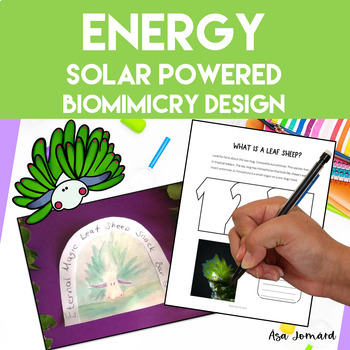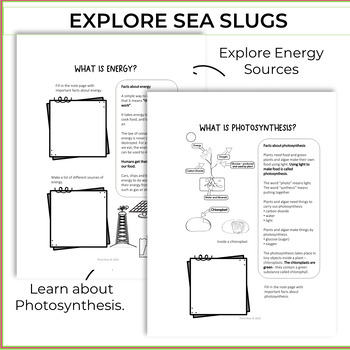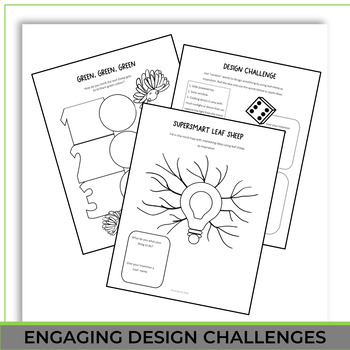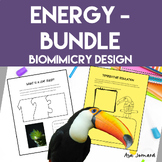Energy | Solar Power | Photosynthesis | Nonfiction | Biomimicry Design Activity
- PDF
What educators are saying
Also included in
- Here is a biomimicry energy bundle to make your science project for students, Grade 3 to Grade 4, both fun and educational. Combine learning about renewable energy with remarkable design challenges inspired by nature and the fascinating bill of the colorful toco toucan. You'll save timePrice $6.00Original Price $8.00Save $2.00
Description
A sea slug as inspiration for solar-powered devices you might think. Here is a biomimicry energy resource to make your science project for students, Grade 3 to Grade 5, both fun and educational. Combine learning about renewable energy with photosynthesis and remarkable design challenges inspired by nature.
This package is designed to deepen students' understanding of energy concepts, solar power, and the intricate process of photosynthesis. By incorporating nonfiction content and captivating biomimicry design activities, this resource aims to spark curiosity, critical thinking, and a profound appreciation for natural energy systems.
The leaf sheep is a fascinating sea slug that sucks out the chloroplasts from an algae. Then, chloroplasts are incorporated into the slugs’ bodies. You could say that the leaf sheep is a solar-powered creature. Your students will love learning about solar energy and photosynthesis!
You'll save time by downloading this easy-to-use introduction to Biomimicry - Bio means Life and Mimic means to imitate life and nature.
What are you waiting for? Purchase this fun, educational and engaging biomimicry resource now and give your students a science activity they'll love.
Contact me at maliasa@live.com if you have any questions, thanks.
Please click the PREVIEW button above to get an idea of everything included.
This inspiring Biomimicry Energy package contains:
1. Teacher Guide
2. What is a leaf sheep?
3. Where do Leaf Sheep live?
4. Remarkable sea slug
5. What is Photosynthesis?
6. My Dictionary - Photosynthesis
7. What is energy?
8. Green, Green, Green
9. Supersmart leaf sheep
10. Mind Maps - My Ideas for a Leaf Sheep Inspired innovation
11. Design Challenge - Random Inspiration
12. Story Writing
13. Make an advert
14. What I learned
15. How to use Biomimciry in the Classroom
Want a resource about robots? Check out Robots | PBL Biomimicry Design Inspired by Nature STEAM Compatible with NGSS
You may also like Project Based Learning: Robot & Architecture, Design Bundle, STEAM, Biomimicry
Leaving feedback when you purchase a resource earns you points toward FREE TPT purchases. I love that feedback!
Also, Follow Me and be notified when new products are uploaded. New products are always 50% off for the first 72 hours they are posted.
Reviews of other Think Dive - Sparking Children's Thinkibility products:
Project based learning: Bats, STEAM, Biomimicry
"This product is absolutely the favorite one I have purchased all fall! I love the information that is provided about bats - just enough to intrigue and encourage higher level thinking. There are graphic organizers, worksheets, and subtle suggestions to help young learners perform at their best! And best of all, it stretches their creativity! Thanks for such an amazing resource!"
Project based learning: Mammals, Reptiles & Amphibians - STEAM, Biomimicry, NGSS
"Used this for a Kindergarten STEAM club unit and it was a hit!"
Why am I qualified to write these biomimicry resources? I was a member of BEN - Biomimicry Education Network - and a curator of educational resources at BEN. I am the author of the book Biomimicry with Theo & Tuva: Nature spotting inspires wild ideas. In 2015, I completed a course in Biomimicry: A Sustainable Design Methodology at Minneapolis College of Art and Design. I took part in the Biomimicry Design Challenge in 2021.
Product Format:
• This download is a PDF and is formatted in US Letter size. If you would prefer an alternate sizing, A4 size or spelling (colour vs color etc.), please leave me a note in the ‘ask a question section of my store'.
#projectbasedlearning #animals #seaslug #solarpower #photosynthesis #nonfiction #biomimicrydesign #algae #STEAM #STEM #NGSS #biomimicry #Designinspirednature #scienceproject #sparkingchildrensthinkibility #thinkdive #asajomard






